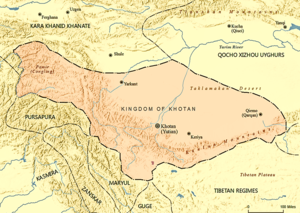
Back مملكة خوتان Arabic Reinu de Jotán AST Xotan dövləti AZ خوتان کراللیغی AZB খোটান Bengali/Bangla ལི་ཡུལ་ BO Regne de Khotan Catalan Chotanské království Czech Kongeriget Khotan Danish Königreich von Hotan German
Kingdom of Khotan 于闐 | |||||||||
|---|---|---|---|---|---|---|---|---|---|
| c. 300 BC–1006 | |||||||||
 Map of the kingdom of Khotan circa 1000. | |||||||||
| Capital | Hotan | ||||||||
| Common languages | Khotanese[web 1] Gāndhārī[web 2] | ||||||||
| Religion | Buddhism | ||||||||
| Government | Monarchy | ||||||||
• c. 56 | Yulin: Jianwu period (25–56 AD) | ||||||||
• 969 | Nanzongchang (last) | ||||||||
| History | |||||||||
• Khotan established | c. 300 BC | ||||||||
• Established | c. 300 BC | ||||||||
• Yarkant attacks and annexes Khotan. Yulin abdicates and becomes king of Ligui | 56 | ||||||||
• Tibet invades and conquers Khotan | 670 | ||||||||
• Khotan held by the Muslim, Yūsuf Qadr Khān | 1006 | ||||||||
• Disestablished | 1006 | ||||||||
| |||||||||
| Today part of | China Tajikistan | ||||||||
The Kingdom of Khotan was an ancient Buddhist Saka kingdom[a] located on the branch of the Silk Road that ran along the southern edge of the Taklamakan Desert in the Tarim Basin (modern-day Xinjiang, China). The ancient capital was originally sited to the west of modern-day Hotan at Yotkan.[1][2] From the Han dynasty until at least the Tang dynasty it was known in Chinese as Yutian. This largely Buddhist kingdom existed for over a thousand years until it was conquered by the Muslim Kara-Khanid Khanate in 1006, during the Islamization and Turkicization of Xinjiang.
Built on an oasis, Khotan's mulberry groves allowed the production and export of silk and carpets, in addition to the city's other major products such as its famous nephrite jade and pottery. Despite being a significant city on the silk road as well as a notable source of jade for ancient China, Khotan itself is relatively small – the circumference of the ancient city of Khotan at Yōtkan was about 2.5 to 3.2 km (1.5 to 2 miles). Much of the archaeological evidence of the ancient city of Khotan however had been obliterated due to centuries of treasure hunting by local people.[3]
The inhabitants of Khotan spoke Khotanese, an Eastern Iranian language belonging to the Saka language, and Gandhari Prakrit, an Indo-Aryan language related to Sanskrit. There is debate as to how much Khotan's original inhabitants were ethnically and anthropologically Indo-Aryan and speakers of the Gāndhārī language versus the Saka, an Indo-European people of Iranian branch from the Eurasian Steppe. From the 3rd century onwards they also had a visible linguistic influence on the Gāndhārī language spoken at the royal court of Khotan. The Khotanese Saka language was also recognized as an official court language by the 10th century and used by the Khotanese rulers for administrative documentation.
Cite error: There are <ref group=web> tags on this page, but the references will not show without a {{reflist|group=web}} template (see the help page).
- ^ Stein, M. Aurel (1907). Ancient Khotan. Oxford: Clarendon Press.
- ^ Charles Higham (2004). Encyclopedia of Ancient Asian Civilizations. Facts on File. p. 143. ISBN 978-0-8160-4640-9.
- ^ Cite error: The named reference
Mallory 2000was invoked but never defined (see the help page).